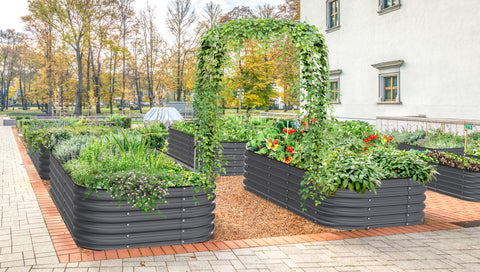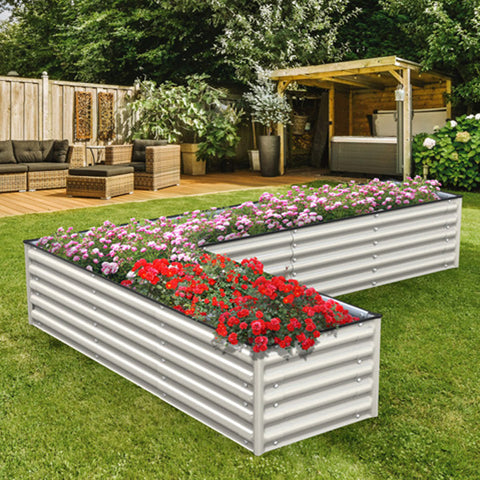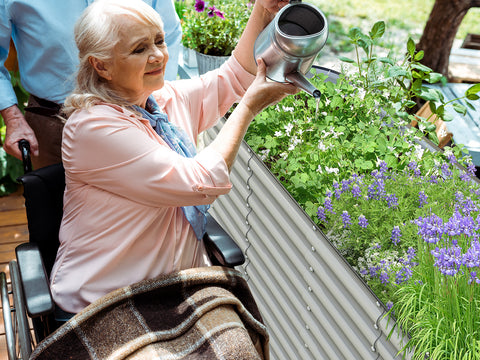The Importance of Urban Gardening
Far from being a trend, urban gardening is here to stay. As the world's population continues to grow, urban gardening will become increasingly popular as people try to figure out ways to grow their own fruits and vegetables and maximize their space.
However, gardening is becoming more popular in cities of all sizes. Read on to learn what urban gardening is and why it's so important. This content also has some reference value for Olle Garden Beds.
What is urban gardening?
Urban gardening is simply gardening done in an urban rather than a rural setting. There are many types of urban gardening.
All of these types may involve the growth of fruits and vegetables, and they can exist alongside chicken or fish farming.
Balconies, back porches, greenhouses, backyards and rooftops can all be home to urban gardens.
Types of urban gardening
Several types of urban gardens can be adapted to different Spaces and experience levels. You can even combine several types to your liking.
While these gardens may often be used for vegetables, you can also grow flowers and herbs in these environments.
Plot garden
A plot garden is the type of garden you might think of when someone describes a garden.
This type is made in backyard or community garden soil. Typically, large urban gardens will be plot gardens.
A plot of land in which plants enter the ground or a raised bed in such a garden. This garden type offers quite a bit of versatility, as you can grow many different plants at once.
Container garden
A container garden consists of a variety of containers for growing plants.
You can use many different types of containers in these gardens, including wooden boxes, half buckets, and raised garden beds.
This type of garden is perfect for those who don't have a lot of space or are cautious about the quality of soil in their space.
Many people choose this option if they only have a small porch or deck.
You can combine this garden type with several other types of gardening. Containers can be used inside the roof garden or outside the plot garden.
Vertical gardens usually require a certain number of containers as the base of a vertical structure.
Roof garden
If you live in a city without a yard, it may be difficult to find space to build your garden. This difficulty is where roof gardens come in.
After securing the roof, create a roof garden by placing planting containers on the roof.
This location provides plenty of sunlight for your plants, but they can also be more exposed to the elements.
To keep the weight low, you may need to use soil at a lower depth, and this reduction may limit your plant size.
Hydroponic garden
Hydroponic gardens use nutrient-rich water instead of soil to grow plants. This type of gardening is usually done indoors in order to control all the relevant elements.
Many people choose this type of garden because of its ability to grow food year-round without relying on the whims of the weather.
Aquaponics Garden
Similar to hydroponic gardening, aquaponics gardening uses nutrient-rich water instead of soil to grow plants.
The big difference is that the nutrients in this water come from fish that live in an aquaponics system.Fish, in turn, benefit from the presence of plants. This relationship creates a closed-loop system.
Select this system if you have some internal space and some time to create it.
Vertical garden
This option is especially good if your square feet are low. Vertical gardening is done by planting plants and vertical structures.
These structures can be trellises, trees and special structures. Grapevines are a logical choice for this garden type, but you can also grow greens, herbs, and many other plants.
Read How to Grow Cabbage in a Container
Why is urban gardening important?
Urban gardening is so important and beneficial to individuals and communities for several reasons.
From helping the environment to improving community health, urban gardening can have a significant impact.
Raise awareness of environmental protection
It's one thing to know about environmental impacts theoretically, but it's another to experience nature firsthand. Often, living in a city makes it hard to connect with nature.
Urban gardening is therefore a great opportunity to learn about nature and how growing food affects the environment.
Getting involved in urban gardening makes it easier to understand why air quality, water quality, biodiversity, soil fertility and resource recycling are critical to the environment.
Good for the environment
In addition to raising awareness of environmental issues, urban gardening can have a positive impact on the health of the environment itself.
Urban gardening helps the environment in several ways, such as encouraging pollinators and creating green Spaces. Green Spaces help the environment in countless ways.
One important way urban gardening can benefit the environment is by reducing the need for food that is shipped thousands of miles to grocery stores.
To keep you cool
If you've spent any time in a city during the summer, you know that it can get hot. This temperature is usually due to a lack of green space.
Gardens and parks help to cool the environment. So if you want to create an oasis in the heat, start an urban garden.
The importance of urban gardening
Protection of traditional knowledge
In past centuries, crops were grown in small gardens using traditional knowledge and seeds.
Urban gardening is a great way to make use of our gardening knowledge. It enables you to learn more about your ancestors and the plants traditionally grown.
It's good for pollinators
Pollinators are vital to the health of our food systems. However, they can be scarce in big cities due to a lack of green Spaces and pollinator-friendly plants.
Having a garden attracts pollinators and helps them thrive. These pollinators, in turn, help your garden grow. Lots of bees and butterflies are a sign of a healthy garden.
Very convenient
While the process of growing food may take some time and planning, once the produce starts coming in, you'll have easy access to all the fresh fruits and vegetables you want.
Those who grow food don't have to go further than their backyard.
Increase adult education
Going to the grocery store to pick up produce can be convenient and easy, but it can leave us disconnected from what goes into our food system.
Gardening enables us to understand how food is grown and gain an appreciation of food production.
And early education for children
Urban gardening can be educational for people of all ages. Getting young children involved in gardening can be very beneficial.
Experiencing urban gardening early in life can instill an understanding and appreciation of fresh fruits and vegetables that will last a lifetime.
Job creation
The existence of urban gardens creates gardening jobs for people in cities.
While small container gardens on balconies don't necessarily create jobs, each helps support the culture of larger urban gardens.
These large gardens grow local food and employ people at all levels of horticulture and production processes.
Sometimes larger urban gardens sell at farmers' markets or supply ingredients for restaurants.
Useful for job training
Not all gardens provide people with paid work. But volunteering in a community garden can be a rich experience.
Working in the garden can teach people skills useful to the workforce. These skills might include collaboration, patience and commitment.
Gardening can also provide a practical understanding of science and mathematics.
Help people get out there
Having an urban garden is a great way to encourage people to get out there.
While some indoor garden types do not necessarily have this benefit, any outdoor garden requires the regular presence of the gardener.
Some urban gardens are open to the public, creating a comfortable space for any community member.
Gardens improve physical and mental health
Working in the garden provides you with the opportunity to move your body and exercise without even realizing it. You may need to periodically lift things, squat down to pull weeds, and walk around.
In addition to your physical health, you can also improve your mental health by spending time in the garden. Your attention span and overall mood can be improved.
Fighting food deserts
An obvious result of urban gardens is access to fresh produce.
Many areas are called "food deserts." The title refers to relying on fast food or understocked grocery stores to eat when fresh food is not available in the community.
Urban gardens can provide fresh produce to people living in food deserts.
Make full use of space
In cities, it is common for some Spaces to be neglected.
An example of this is an abandoned lot flooded with weeds and garbage. This space can be turned into a rich garden that provides fresh food for the community.
Even small Spaces can be used smartly, adding vertical garden or Halle bundle planters. If used efficiently, the space is not wasted.
Provide fresh food
The availability of this produce helps community members eat healthier and understand the importance of fresh fruits and vegetables.
The presence of fresh fruits and vegetables can also encourage creative cooking practices. This opens up a way for friends and family to bond.
Help you make friends
Urban gardens can often affect more people than you think.
Even if you just grow a few vegetables in a vertical garden on your porch, sharing those vegetables can grow your community.
You can also join a local community of amateur gardeners.
Build community
For larger gardens, you can involve community members in garden care or community meals made from garden products.
The existence of an urban garden can provide something for the community to unite and contribute. Those who are connected to a community garden can connect with nature.
Create beauty
In addition to being useful, gardens are loved for their beauty.
Whether you grow flowers, produce, or both, your urban garden can provide aesthetic value to your community. Gardens can even increase the value of your property.
Frequently asked Questions about urban gardening
How can urban gardening help the environment?
There are several ways that urban gardening can help the environment. First, it can help reduce pollution in cities. That's because when people have access to fresh produce grown in their own backyards or community gardens, they're less likely to buy food shipped from afar, which means there will be less traffic on the roads, which means less pollution.
Urban gardening can also help save energy and resources. For example, if people use organic methods to grow their own vegetables, they won't rely on transportation and distribution systems that use fossil fuels. When people recycle nutrients back into the soil through compost, it reduces the need for fertilizers and pesticides.
What are the effects of urban farming?
Urban farming or gardening has become increasingly popular in recent years. One of the main reasons for this is that people are increasingly interested in where their food comes from and how it is grown.
Urban gardening has many benefits, the biggest of which is that it helps improve access to fresh fruits and vegetables in low-income areas. It also helps reduce pollution because you are growing food in an area that would otherwise be used for parking or development. Finally, it helps to build community bonds and relationships within the community.
How can urban Agriculture Help World Hunger?
Urban agriculture can help world hunger by providing fresh produce in areas where healthy food is limited.
Moreover, urban agriculture helps fight world hunger in another way: it reduces the amount of food wasted. According to the United Nations, about a third of all food produced for human consumption is wasted. 1.3 billion tons of food are wasted every year. If this food were used to feed hungry people, it would be enough to eliminate world hunger.
Urban farming helps reduce food waste and keeps produce fresh longer because crops are grown closer to where they are eaten. This also eliminates the need to transport fruit and vegetables long distances, thereby reducing carbon dioxide emissions and saving energy.
What are the goals of urban agriculture?
The goal of urban agriculture is to provide city dwellers with fresh, healthy and affordable produce. The goal of urban agriculture is to bring healthy, fresh produce to areas where it is not normally available.
One of the main benefits of urban farming is that it helps reduce the amount of food wasted. About 30-40% of food produced in the United States is wasted, according to the US Department of Agriculture. That's a lot of food!
Urban agriculture also helps improve air quality and reduce greenhouse gas emissions. Finally, it provides an opportunity for people to exercise and connect with their community.
How can urban gardening help provide sustainable food?
Urban gardening can help provide sustainable food in a number of ways. One way is to reduce reliance on food production systems far from urban areas and instead bring food production closer to where people live. This reduces the amount of fuel needed to transport food over long distances, thereby reducing greenhouse gas emissions and helping to conserve energy.
Another way urban gardening can help provide sustainable food is by increasing the density of vegetable and fruit production in cities. This can be done, for example, by using vertical or rooftop gardens, which maximise the available space and reduce the amount of land devoted to growing flowers or grass instead of vegetables and fruit.




